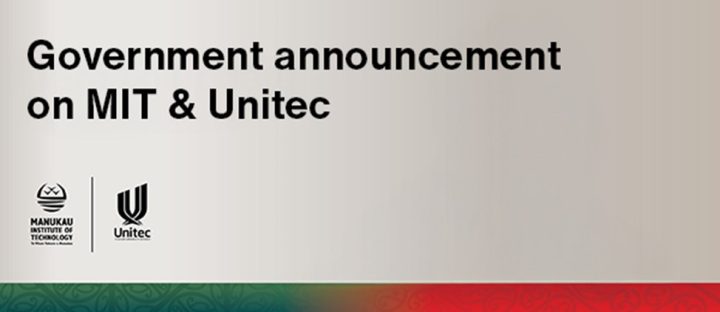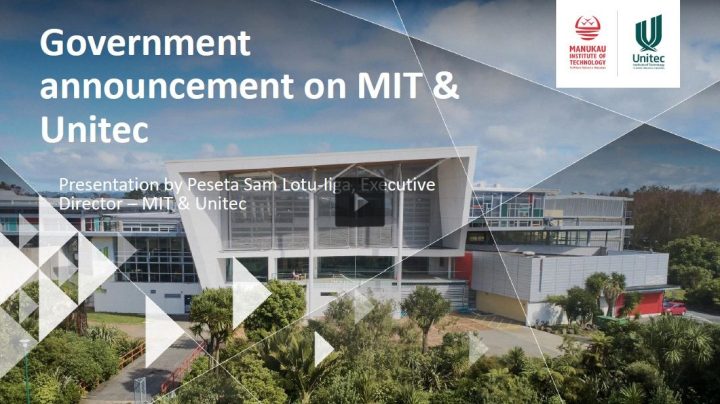
Nau mai, haere mai,
Welcome! We’ll be sharing updates, presentations and FAQs on transition through this page.
You can read the Minister’s press release here.
News & Updates:
Unitec & MIT Government Announcement presentation

Frequently Asked Questions for Kaimahi
It’s important kaimahi have the information they need to understand what has been announced, what it means for them and get to ask questions.
This list will be updated as we move forward with transition. If you have a question you’d like to ask, please contact communications@unitec.ac.nz
What has been announced?
Minister for Vocational Education Hon. Penny Simmonds has announced our divisions will transition to a single independent legal entity, as of January 1, 2026.
What does this mean?
It means MIT and Unitec, currently business divisions of Te Pūkenga, will exit the national network in the new year as a single independent legal entity for the delivery of on campus vocational education and training in Tāmaki Makaurau – Auckland.
We have demonstrated a robust enough pathway to financial viability to satisfy the Government’s criteria for independence.
What are the benefits of operating as a single entity?
MIT and Unitec as a single entity will form a significant education provider not only in our city, but in the national context.
It affords us the scale and capability to allow vocational education to support and grow the people, businesses and services of the region.
It gives us the opportunity to work more closely with our partners to create a platform for delivering training that is more responsive to local needs, as well as providing greater accessibility for those across Tāmaki wishing to partner and use our services.
What are the benefits of being independent?
It allows us to resume and enhance the important work our providers have been doing for more than fifty years, alongside our communities designing training solutions, pathways and support to meet their needs.
What do we need to do this year to prepare for transition to independence?
On this side of the new year, our main focus will be on supporting the implementation of the fundamental legal and operational requirements necessary to achieve transition.
Our transition to the single entity requires a Transition Plan consulted on with NZQA and approved by Tertiary Education Commission’s Board.
The Minister will appoint an Establishment Advisory Group. That group appoints the Chief Executive and governance committees, approves delegations and other legally mandated requirements.
We will work with Te Pūkenga to review current policies and procedures to establish which will be taken forward.
We will appoint a Deputy Chief Executive – Māori to uphold Te Tiriti relationships through transition and beyond.
How will we be operating in the future under a single entity?
It is important to understand the brief of the new entity will not be the same as the nationally structured Te Pūkenga or what previously existed at MIT and Unitec.
We are being asked to further pursue learner-centredness, industry engagement, community focus and values-based leadership in a regional context.
A vision for the new entity will be developed and approved by its Board and enacted by its Leadership team.
Ultimately, we will be governed by a single board, led by a Chief Executive and a single Executive Leadership Team.
Kaimahi will be fully consulted on this future direction and – it is expected – once developed we will be following a single regionally-focused operating model.
What does this mean for MIT and Unitec as providers?
We acknowledge and respect the trust and reputation our divisions have built with their communities through the work they have done over more than fifty years, as well as the significance these identities hold for us as kaimahi.
Current Senior Leadership Team at MIT and Unitec will be recommending to the incoming Board that the brands, identities, their principles, value systems and approaches to Te Tiriti remain in place for the foreseeable future pending the important, wide-ranging discussion on how we proceed with finding the best way to represent who we are and what we do with our stakeholders.
What brands should we use when we are engaging with the public?
Please continue using our current brands.
Why was the decision not taken to return to two standalone providers in the region, as it was pre-Te Pūkenga?
The financial sustainability of MIT and Unitec as separate entities was evaluated as part of the Regional ITP Viability Project.
Reintroducing separate independent entities at MIT and Unitec would require separate governance and leadership arrangements, as well as reestablishing support functions such as Finance, IT and HR at each entity.
This would cost each provider millions of dollars a year and without necessarily delivering better outcomes.
What does this mean for job security at both providers?
We understand the obvious interest in this question and acknowledge the extended period of change our kaimahi have been through in recent years.
It is too early to tell.
Fully realising the regionally-focused intent of the single entity and an organisational structure to support it will be the responsibility of the incoming Board and its Executive Leadership.
It is important to note in the legislation under which the single entity will be established, roles offered to kaimahi with the new entity must include equivalent terms of employment they had with Te Pūkenga.
Any proposed changes to roles impacting staff will be consulted on with affected kaimahi in accordance with all legal and industrial relations requirements.
We will continue to focus on supporting financial viability as we move toward transition.
How do I access support if I need it?
MIT and Unitec kaimahi can access free, 24-hour support through Vitae. Appointments can be made online or via phone by calling Vitae 0508 664 981.
From August 1
Unitec
Appointments can be made online or via phone by calling: Vitae 0508 664 981 anytime 24/7 or online appointment


